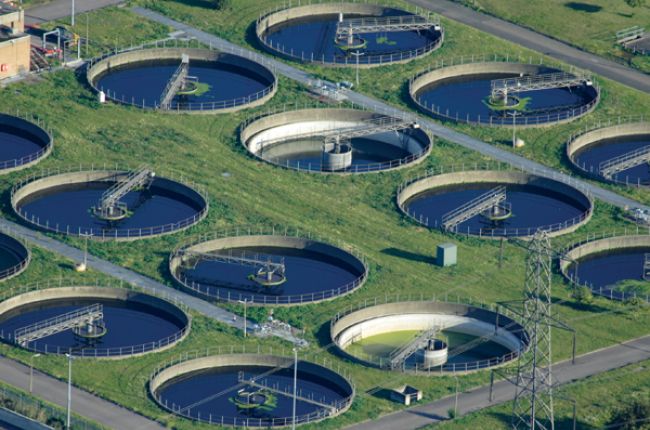Innovative Strategies to Waste Water Treatment Technologies
Innovative Strategies to Waste Water Treatment Technologies
Blog Article
Strategic Approaches to Enhance Drainage Treatment Performance and Reduce Ecological Influence
In the realm of waste water treatment, the pursuit for enhanced performance and decreased ecological effect is a continuous difficulty that requires tactical remedies. The combination of innovative treatment modern technologies, energy-efficient processes, source healing strategies, improved nutrient elimination techniques, and wise tracking and control systems represents a diverse framework for resolving these pushing concerns.
Advanced Treatment Technologies
Innovative membrane filtration systems have revolutionized advanced wastewater treatment processes, dramatically boosting the elimination of pollutants. These innovative systems function by requiring water via a semi-permeable membrane, properly separating pollutants from the water stream. The membrane's tiny pores trap toxins such as bacteria, viruses, and put on hold solids, enabling only cleansed water to pass through. This modern technology has actually proven to be very effective in getting rid of a wide variety of impurities, consisting of pharmaceuticals, heavy metals, and natural compounds, which are usually testing to remove with typical therapy techniques.
Additionally, membrane layer purification systems provide numerous advantages over traditional therapy approaches. They require less area, create higher-quality effluent, and are more resistant to fluctuations in influent water high quality. Furthermore, these systems are highly versatile and can be quickly integrated into existing therapy plants or made use of as standalone devices for decentralized applications. As the need for tidy water remains to rise, the fostering of sophisticated membrane layer filtration technologies is necessary to ensure lasting and efficient wastewater therapy methods.
Energy-Efficient Procedures
The combination of energy-efficient processes in wastewater therapy systems is important for optimizing source application and reducing functional costs. By carrying out energy-efficient modern technologies, treatment plants can substantially reduce their carbon footprint and total environmental impact. One crucial technique to enhancing energy efficiency in wastewater therapy is the use of advanced aeration systems, such as fine bubble diffusers or surface area aerators, which can improve oxygen transfer effectiveness and reduce energy consumption. In addition, integrating energy healing systems, like anaerobic digestion for biogas manufacturing or utilizing excess warm for thermal processes, can aid offset energy demands and advertise sustainability.
Moreover, enhancing procedure control and automation with using sophisticated sensors and keeping track of systems can improve overall energy performance by readjusting operations in real-time based upon real demand and conditions. Executing energy audits and on a regular basis keeping track of energy efficiency signs are necessary techniques to determine areas for renovation and track energy-saving efforts effectively. On the whole, the adoption of energy-efficient processes in wastewater treatment not only benefits the setting yet likewise contributes to long-term cost financial savings and functional sustainability.
Resource Healing Strategies
With an emphasis on enhancing resource application and sustainability in wastewater therapy systems, the implementation of source recovery strategies arises as a critical element in boosting functional effectiveness. Resource healing strategies in wastewater treatment include the identification and extraction of important resources from the waste stream, thereby transforming what was once taken into consideration waste into a beneficial possession. By executing source recuperation techniques such as nutrient elimination and recuperation, power generation from organic matter, and the manufacturing of recyclable water, wastewater therapy plants can decrease ecological effect while maximizing effectiveness.

Boosted Nutrient Removal Methods
Applying sophisticated nutrient removal strategies is important for optimizing the effectiveness of wastewater therapy systems. Boosted nutrient elimination plays an important function in lessening the ecological impact of cured effluent released right into water bodies. One of the essential strategies made use of for improved nutrient elimination is the process of organic nutrient removal (BNR), which entails the removal of nitrogen and phosphorus via biological processes. This can be attained with making use of specialized bacteria that can transform nitrogen substances into inert nitrogen gas with denitrification, and accumulate phosphorus within their cells with a procedure called improved biological phosphorus removal (EBPR)

In enhancement to BNR, advanced therapy methods such as membrane layer bioreactors (MBRs) and built wetlands can likewise be used to boost nutrient elimination effectiveness. By including these advanced nutrient removal techniques right into wastewater treatment markets, districts and systems can successfully reduce nutrient pollution and protect the setting.
Smart Monitoring and Control Equipment
Making use of sophisticated technology, the integration of wise tracking and control systems transforms the operational efficiency of wastewater therapy centers. These systems include advanced sensors and information analytics to continuously monitor key parameters such as pH levels, turbidity, liquified oxygen, and flow prices in real-time. By accumulating and analyzing this data, drivers can gain valuable understandings right into the performance of the treatment processes, Read More Here allowing aggressive changes to maximize therapy effectiveness.
Smart tracking and control systems also sustain remote monitoring capabilities, allowing drivers to gain access to real-time information and control features from off-site locations. This remote ease of access enhances operational flexibility and responsiveness, making it possible for speedy treatments in situation of system malfunctions or variations in influent quality. The predictive maintenance capabilities of these systems aid protect against equipment failures and reduce downtime, ultimately enhancing the total reliability of wastewater treatment operations.
Final Thought
In verdict, critical methods such as sophisticated treatment technologies, energy-efficient procedures, resource recuperation methods, boosted nutrient removal methods, and smart monitoring browse around this web-site and control systems play an essential duty in enhancing wastewater therapy effectiveness and decreasing ecological effect. By applying these methods, wastewater treatment plants can boost their general efficiency, reduce energy usage, recoup useful sources, and make sure compliance with ecological regulations. These methods are essential for reliable and sustainable wastewater management practices.

In verdict, critical approaches such as advanced therapy technologies, energy-efficient procedures, source healing her comment is here techniques, enhanced nutrient removal techniques, and smart tracking and control systems play an essential duty in boosting wastewater therapy effectiveness and minimizing environmental influence.
Report this page